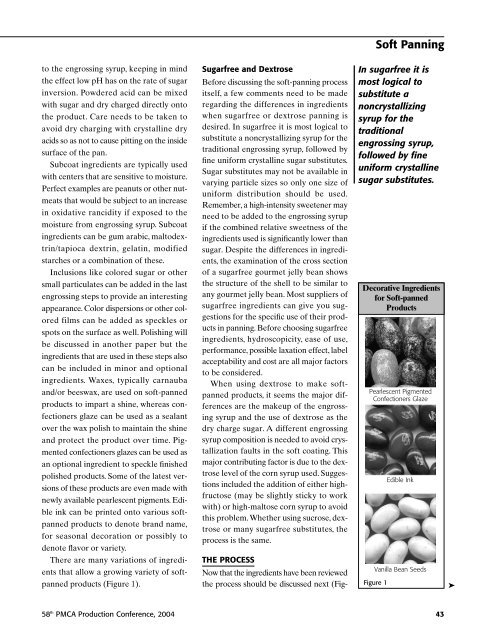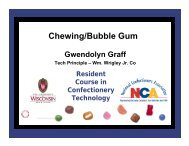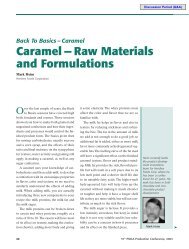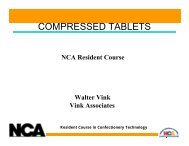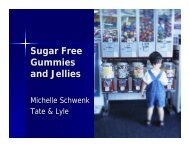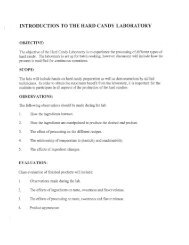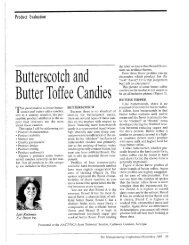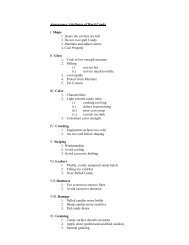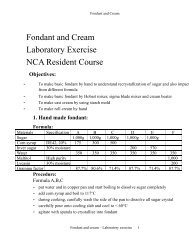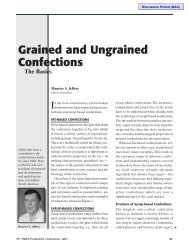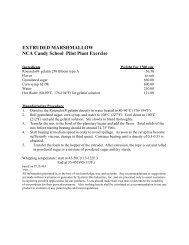2004 Soft Panning - staging.files.cms.plus.com
2004 Soft Panning - staging.files.cms.plus.com
2004 Soft Panning - staging.files.cms.plus.com
You also want an ePaper? Increase the reach of your titles
YUMPU automatically turns print PDFs into web optimized ePapers that Google loves.
to the engrossing syrup, keeping in mind<br />
the effect low pH has on the rate of sugar<br />
inversion. Powdered acid can be mixed<br />
with sugar and dry charged directly onto<br />
the product. Care needs to be taken to<br />
avoid dry charging with crystalline dry<br />
acids so as not to cause pitting on the inside<br />
surface of the pan.<br />
Subcoat ingredients are typically used<br />
with centers that are sensitive to moisture.<br />
Perfect examples are peanuts or other nutmeats<br />
that would be subject to an increase<br />
in oxidative rancidity if exposed to the<br />
moisture from engrossing syrup. Subcoat<br />
ingredients can be gum arabic, maltodextrin/tapioca<br />
dextrin, gelatin, modified<br />
starches or a <strong>com</strong>bination of these.<br />
Inclusions like colored sugar or other<br />
small particulates can be added in the last<br />
engrossing steps to provide an interesting<br />
appearance. Color dispersions or other colored<br />
films can be added as speckles or<br />
spots on the surface as well. Polishing will<br />
be discussed in another paper but the<br />
ingredients that are used in these steps also<br />
can be included in minor and optional<br />
ingredients. Waxes, typically carnauba<br />
and/or beeswax, are used on soft-panned<br />
products to impart a shine, whereas confectioners<br />
glaze can be used as a sealant<br />
over the wax polish to maintain the shine<br />
and protect the product over time. Pigmented<br />
confectioners glazes can be used as<br />
an optional ingredient to speckle finished<br />
polished products. Some of the latest versions<br />
of these products are even made with<br />
newly available pearlescent pigments. Edible<br />
ink can be printed onto various softpanned<br />
products to denote brand name,<br />
for seasonal decoration or possibly to<br />
denote flavor or variety.<br />
There are many variations of ingredients<br />
that allow a growing variety of softpanned<br />
products (Figure 1).<br />
Sugarfree and Dextrose<br />
Before discussing the soft-panning process<br />
itself, a few <strong>com</strong>ments need to be made<br />
regarding the differences in ingredients<br />
when sugarfree or dextrose panning is<br />
desired. In sugarfree it is most logical to<br />
substitute a noncrystallizing syrup for the<br />
traditional engrossing syrup, followed by<br />
fine uniform crystalline sugar substitutes.<br />
Sugar substitutes may not be available in<br />
varying particle sizes so only one size of<br />
uniform distribution should be used.<br />
Remember, a high-intensity sweetener may<br />
need to be added to the engrossing syrup<br />
if the <strong>com</strong>bined relative sweetness of the<br />
ingredients used is significantly lower than<br />
sugar. Despite the differences in ingredients,<br />
the examination of the cross section<br />
of a sugarfree gourmet jelly bean shows<br />
the structure of the shell to be similar to<br />
any gourmet jelly bean. Most suppliers of<br />
sugarfree ingredients can give you suggestions<br />
for the specific use of their products<br />
in panning. Before choosing sugarfree<br />
ingredients, hydroscopicity, ease of use,<br />
performance, possible laxation effect, label<br />
acceptability and cost are all major factors<br />
to be considered.<br />
When using dextrose to make softpanned<br />
products, it seems the major differences<br />
are the makeup of the engrossing<br />
syrup and the use of dextrose as the<br />
dry charge sugar. A different engrossing<br />
syrup <strong>com</strong>position is needed to avoid crystallization<br />
faults in the soft coating. This<br />
major contributing factor is due to the dextrose<br />
level of the corn syrup used. Suggestions<br />
included the addition of either highfructose<br />
(may be slightly sticky to work<br />
with) or high-maltose corn syrup to avoid<br />
this problem.Whether using sucrose, dextrose<br />
or many sugarfree substitutes, the<br />
process is the same.<br />
THE PROCESS<br />
Now that the ingredients have been reviewed<br />
the process should be discussed next (Fig-<br />
<strong>Soft</strong> <strong>Panning</strong><br />
In sugarfree it is<br />
most logical to<br />
substitute a<br />
noncrystallizing<br />
syrup for the<br />
traditional<br />
engrossing syrup,<br />
followed by fine<br />
uniform crystalline<br />
sugar substitutes.<br />
Decorative Ingredients<br />
for <strong>Soft</strong>-panned<br />
Products<br />
Pearlescent Pigmented<br />
Confectioners Glaze<br />
Figure 1<br />
Edible Ink<br />
Vanilla Bean Seeds<br />
58 th PMCA Production Conference, <strong>2004</strong> 43<br />
➤


